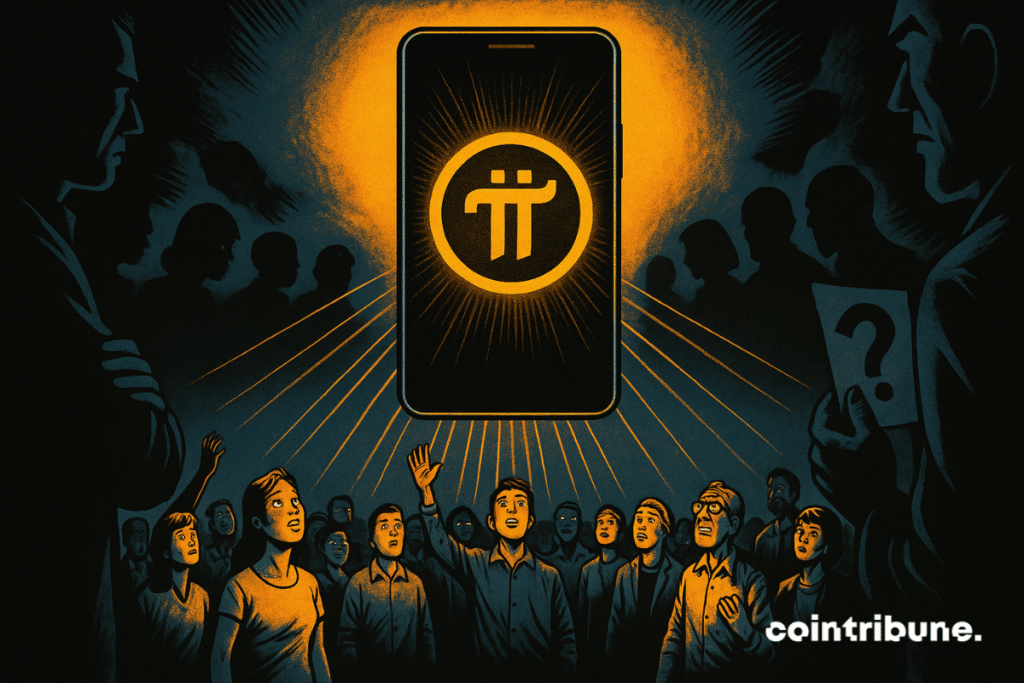Community Hype Fuels Pi Network As Red Flags Grow
Pi Network, launched in 2019 to democratize mobile mining, gathers millions of users. Yet, its token still has no real value, and its blockchain remains under control. Since the partial opening of its mainnet, the project oscillates between collective fascination and technical warning signs. Centralization, lack of transparency, invasive KYC… despite everything, enthusiasm does not wane. Why does such a controversial project continue to unite people?

In brief
- Pi Network attracts millions of users, despite a lack of listing on major platforms like Binance and a token in sharp decline.
- The launch of the mainnet last February triggered a brief enthusiasm, before technical and structural problems slowed momentum.
- Many criticisms arise: total network centralization, opacity of token distribution, and suspicions of suspicious activity on some wallets.
- Despite everything, the hype persists: mobile accessibility, no fees, gamification, and strong community identity partly explain ongoing adherence.
A highly anticipated launch, but a mixed deployment
In February, the announcement of the opening of Pi Network’s mainnet to external exchanges triggered a real enthusiasm in the ecosystem
Indeed, the crypto price climbed to nearly 3 dollars shortly after this announcement, driven by hopes of massive adoption. However, reality soon caught up with the initial enthusiasm. In September, the token price collapsed to about 0.34 dollar, a loss of nearly 90 % in just a few months.
This drop is explained by a series of technical and organizational malfunctions : “migration delays, queues for KYC verifications, and unequal network access” greatly slowed scaling and frustrated users.
Several weak signals trigger structural concerns about the project’s reliability and transparency :
- Network centralization : although Pi claims to be an open network, all node validators remain under the control of the project developers. No independent community validator is yet active.
- Opaque token distribution : the whitepaper provides for a total supply (100 billion) split among the community, the team, and reserves, but these tokens are only released based on complex technical criteria related to mining rewards, making circulating supply difficult to assess.
- Suspicious wallet activity : a wallet identified as “GAS…ODM” alone has accumulated 331 million Pi tokens, raising questions about possible undeclared internal activity or disproportionate control by a central actor.
- Absence from major exchanges : the crypto is only listed on secondary platforms like OKX, Bitget, or MEXC. Binance and Coinbase still refuse to integrate it, citing persistent doubts about governance and transparency.
- A controversial KYC policy : to migrate their Pi to the mainnet, users must undergo strict KYC including identity document and biometric selfie. This data is stored on centralized servers, raising serious privacy concerns.
At this point, the initial promise of an inclusive and decentralized network seems strongly weakened by power centralization, lack of clarity on monetary supply, and worrying signals on user data management.
A viral mechanism that resists market logic
Despite these documented alerts, Pi Network crypto continues to attract millions of users.
Pi continues to generate remarkable enthusiasm despite growing operational and structural concerns. How to explain such persistence of interest? The secret may lie in the very nature of the project: a mobile application, with no technical requirement, free to use, that turns the act of mining into a simple touch routine.
Unlike traditional blockchains, users do not need GPUs or initial investment. Such radical accessibility massively attracts novice profiles, often from underbanked countries or seeking alternative digital opportunities.
But beyond the usage model, it is the community and social dimension that seems to keep the machine running. Users are called “Pioneers”, and the app gamifies the experience through “security circles” and referral bonuses. Regular events like “PiFest or Map of Pi” maintain engagement, while the ecosystem feeds on hackathon announcements, developer funds, or experimentation campaigns.
Certainly, these initiatives often remain symbolic or limited in real scope, but they sustain the illusion of a project in progress. For many, the narrative outweighs reality.
The strength of Pi Network crypto does not lie in its current technology or token performance. It resides in a powerful narrative and community model, which combines hope, accessibility, and belonging. However, can this dynamic survive the test of time and transparency ? Without real decentralization, concrete adoption, and clarification on personal data management, Pi Network risks getting stuck in the Web3, never crossing the threshold of real utility.
Maximize your Cointribune experience with our "Read to Earn" program! For every article you read, earn points and access exclusive rewards. Sign up now and start earning benefits.
Diplômé de Sciences Po Toulouse et titulaire d'une certification consultant blockchain délivrée par Alyra, j'ai rejoint l'aventure Cointribune en 2019. Convaincu du potentiel de la blockchain pour transformer de nombreux secteurs de l'économie, j'ai pris l'engagement de sensibiliser et d'informer le grand public sur cet écosystème en constante évolution. Mon objectif est de permettre à chacun de mieux comprendre la blockchain et de saisir les opportunités qu'elle offre. Je m'efforce chaque jour de fournir une analyse objective de l'actualité, de décrypter les tendances du marché, de relayer les dernières innovations technologiques et de mettre en perspective les enjeux économiques et sociétaux de cette révolution en marche.
The views, thoughts, and opinions expressed in this article belong solely to the author, and should not be taken as investment advice. Do your own research before taking any investment decisions.